Chaotic and Lawful Alignments in Poul Anderson’s Three Hearts and Three Lions
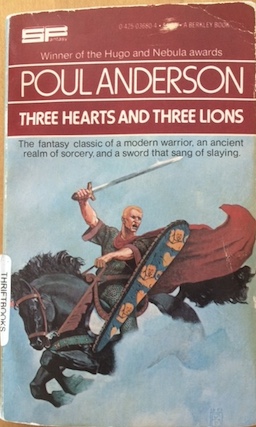 I’m willing to bet that Poul Anderson’s Three Hearts and Three Lions published in 1953 in The Magazine of Fantasy and Science Fiction (and Anderson’s close friend and frequent collaborator Gordon R. Dickson’s St. Dragon and the George, published likewise in The Magazine of Fantasy and Science Fiction at about the same time – later republished as The Dragon and the George) owes quite a bit to Mark Twain’s A Connecticut Yankee in King Arthur’s Court. And Anderson doesn’t disguise this, for he at least once overtly references Twain’s historical romance when he has his protagonist, Holger Carlsen (a “Carl” again!), unconvincingly scare away a band of barbarians by using his tobacco pipe to blow smoke out of his mouth. The work further encourages comparisons to Twain’s book through Holger’s use of other “Enlightenment” tricks in a secondary world, and Anderson uses bookends reminiscent of Twain’s. Anderson’s bookends here are worth a closer look.
I’m willing to bet that Poul Anderson’s Three Hearts and Three Lions published in 1953 in The Magazine of Fantasy and Science Fiction (and Anderson’s close friend and frequent collaborator Gordon R. Dickson’s St. Dragon and the George, published likewise in The Magazine of Fantasy and Science Fiction at about the same time – later republished as The Dragon and the George) owes quite a bit to Mark Twain’s A Connecticut Yankee in King Arthur’s Court. And Anderson doesn’t disguise this, for he at least once overtly references Twain’s historical romance when he has his protagonist, Holger Carlsen (a “Carl” again!), unconvincingly scare away a band of barbarians by using his tobacco pipe to blow smoke out of his mouth. The work further encourages comparisons to Twain’s book through Holger’s use of other “Enlightenment” tricks in a secondary world, and Anderson uses bookends reminiscent of Twain’s. Anderson’s bookends here are worth a closer look.
Holger Carlsen’s history, as relayed by an unspecified narrator, funhouse-mirrors Anderson’s personal history. In a book profiling Supernatural Fiction Writers, Ronald Tweet reports that Anderson was born to Danish parents and lived in Denmark for a while previous to WWII. Holger of Three Hearts and Three Lions is a Dane who, after wandering Europe, starts attending an Eastern university in the U.S. When WWII breaks out, he goes back to Denmark, where, through fairly compressed and elliptical telling, the narrator says that Holger eventually ends up in a pistol fight with Germans. At this point, “all his world [blows] up in flame and darkness.” And Holger finds himself in a fantasy world.
In light of Anderson’s own biographical information, one is tempted to believe that much of this work is the result of a highly personal fantasy, a kind of daydream out of which many fantasies certainly must arise. I’m sure that most of us have fantasized about being an important person in an important place – If only we could get there, somehow!
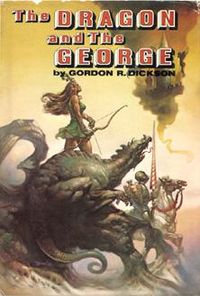 Miesel points out how this book elucidates Anderson’s theme about a cosmic war between Chaos and Law (Dickson and Anderson indeed work closely together, for in The Dragon and the George the conflict is between the forces of “Chance” and “History”), though, to do so, she focuses more on a later book that I’ll be reviewing for this series, Operation Chaos. In short, Holger must fight in the service of Law against the hordes of Chaos, and part of doing so is finding out who he is, which involves getting the magic sword Cortana. When he touches it, he realizes that he has fought this unending war on at least three other occasions, on at least three other fronts, once in an unremembered life in this “Middle World,” once in service to Charlemagne in Carolingian France, and once most recently against the Nazis in Denmark:
Miesel points out how this book elucidates Anderson’s theme about a cosmic war between Chaos and Law (Dickson and Anderson indeed work closely together, for in The Dragon and the George the conflict is between the forces of “Chance” and “History”), though, to do so, she focuses more on a later book that I’ll be reviewing for this series, Operation Chaos. In short, Holger must fight in the service of Law against the hordes of Chaos, and part of doing so is finding out who he is, which involves getting the magic sword Cortana. When he touches it, he realizes that he has fought this unending war on at least three other occasions, on at least three other fronts, once in an unremembered life in this “Middle World,” once in service to Charlemagne in Carolingian France, and once most recently against the Nazis in Denmark:
Holger Danske, whom the old French chronicles know as Ogier le Danois, mounted into the saddle. And this was the prince of Denmark who in his cradle was given strength and luck and love by such of Faerie as wish men well. He it was who came to serve Carl the Great and rose to be among the finest of his knights, the defender of Christendie and mankind. He it was who smote Carahue of Mauretania in battle, and became his friend, and wandered far with him. He it was who Morgan le Fay held dear; and when he grew old, she bore him to Avalon and gave him back his youth. There he dwelt until the paynim again menaced France, a hundred years later, and thence he sallied forth to conquer them anew. Then in the hour of his triumph he was carried away from mortal men.
This somewhat Joycean epiphany is tonally out of pitch with the rest of the novel, which reads as a fairly light-hearted, full-color adventure yarn. This passage in fact occurs at just about the end of the book. An endnote, given by the narrator in order to accomplish the other requisite bookend and to follow the bookend tradition of reinforcing the ambiguity and uncanny nature of the relation, brings the hero out of the Middle World suddenly naked – with just a touch of comic effect – back into his earlier conflict with the Nazis. Some closing comments leave the veracity of the tale unresolved but with enough uncanny clues to suggest that the telling is indeed true.
Before getting to the strengths of this book, I’d point briefly to what aggravates. Chiefly is Holger’s “manly,” overgrown boy attitude and his consequent latent chauvinism, which very well may be an unintended side effect of Anderson’s time of composition.
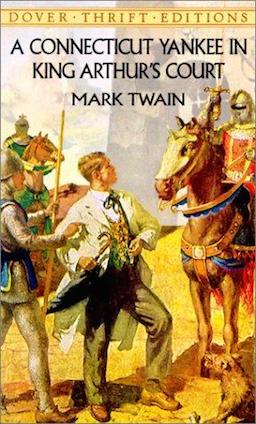 Holger is in a love triangle – or quadrangle, if we include the quickly forgotten elf-seductress Meriven. In the triangle’s simplest reading, Holger desires both the “good girl,” the “right” one, the one whom the readers know he should want (again, the ethos of this book seems highly constructed from the time) and the “bad girl,” the one whom the readers should hate and go ooh, boo! – Morgan le Fey. The good girl, of course, appears in white. Her name is Alianora. She is a good fairy type – a swan-may (an elf-type who can turn into a swan) who routinely is described as very young and childlike. To Anderson’s credit, she has a healthy sexual appetite – she makes it clear that she wants to sleep with Holger. But, for most of the novel, Holger resists her (only semi-consciously fondling her breast at one point), because he is determined to leave this Middle World for his proper world and presumes that his leaving can only break her heart. In case you don’t recognize this as chauvinism, allow me to point out that Holger assumes that he is all that important to Alianora and, out of a perception that “he knows best,” denies her the freedom even of making her own choice in this. Contrastingly, he thinks it would be perfectly okay to sleep with Morgan, and probably doesn’t do so, at one point, only because of Alianora’s untimely intrusion.
Holger is in a love triangle – or quadrangle, if we include the quickly forgotten elf-seductress Meriven. In the triangle’s simplest reading, Holger desires both the “good girl,” the “right” one, the one whom the readers know he should want (again, the ethos of this book seems highly constructed from the time) and the “bad girl,” the one whom the readers should hate and go ooh, boo! – Morgan le Fey. The good girl, of course, appears in white. Her name is Alianora. She is a good fairy type – a swan-may (an elf-type who can turn into a swan) who routinely is described as very young and childlike. To Anderson’s credit, she has a healthy sexual appetite – she makes it clear that she wants to sleep with Holger. But, for most of the novel, Holger resists her (only semi-consciously fondling her breast at one point), because he is determined to leave this Middle World for his proper world and presumes that his leaving can only break her heart. In case you don’t recognize this as chauvinism, allow me to point out that Holger assumes that he is all that important to Alianora and, out of a perception that “he knows best,” denies her the freedom even of making her own choice in this. Contrastingly, he thinks it would be perfectly okay to sleep with Morgan, and probably doesn’t do so, at one point, only because of Alianora’s untimely intrusion.
Outdated (we hope!) chauvinist attitudes aside, we might consider this triangle an interesting sexual metaphor for Anderson’s cosmic conflict between Law and Order – Alianora standing in for Order and all the “proper” and “man knows best” ethos that come with it; and Morgan for unbridled sexuality and disregard for consequences, imagined or otherwise. If we push this metaphor to the edge, we know that Holger’s choice isn’t necessarily either/or, because Alianora would make a perfectly suitable sexual companion, providing perhaps even more sexual satisfaction than Morgan may. So, consequently, the reader wonders what Anderson might have meant, consciously or not.
Anderson’s strengths moreover lie in Holger’s faerie encounters. Anderson appears to have a lot of fun with his process of mingling scientific understanding with fantasy conventions. Some of my favorites are as follows: At one point Anderson defeats a dragon by dunking a pot of water down its gullet. No, contrary to what one might think, this does not extinguish the flames but instead results in steam combustion, which makes the dragon very uncomfortable and results in him leaving. Another great one is when Holger, through a protracted riddle game reminiscent of The Hobbit, tricks an ogre into being caught out with the sun. The ogre turns into stone. This transformation accords well with what we fantasy readers already are used to, but then:
What was that smell? Not the stink of the hides, but another, a faint sniff as of rainstorms, under this clear dawn sky. … Ozone? Yes. But how come?
Abruptly, Holger frantically hastens all of his companions away. They vocally wonder why. Holger thinks:
But how could he have gotten the truth across? He himself had no real grasp of atomic theory. He’d only learned in college about experiments in transmutation by such men as Rutherford and Lawrence, and about radium burns. … When carbon was changed to silicon, you were bound to get a radioactive isotope; and tons of material were involved.
This is impressive stuff. I liked it when Leiber really thought through his magical intrusions into his universe of Nehwon. Though Anderson’s scientific considerations don’t do quite the same thing, they’re similarly impressive. And yet I wonder why Holger was so confident that the natural world – down to the atomic level – would operate just the same in the Middle World, particularly since he was encountering things like elves and swan-mays and dwarves. It’s funny how Holger is so certain that what he understands about the natural universe would even hold true in this place. It’s likewise worthy to wonder why the faerie folk he encounters don’t understand these natural laws for themselves. This observation again reminds me of Twain’s Connecticut Yankee in the way that the Yankee is able to import his understanding from the future into King Arthur’s world and henceforth manipulate the environment to his own benefit and accomplishment. He begins this, famously enough, by pretending a solar eclipse is the work of his own magic. Both Twain and Anderson demonstrate faith in a universe built according to Law indeed.
But what precisely is this concept of Law, and what is its opposite, Chaos, after all?
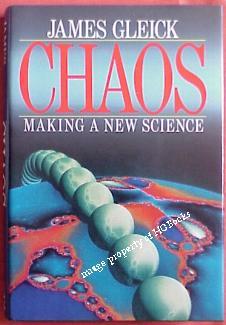 I myself don’t know much about chaos theory (perhaps Andrew Zimmerman Jones will do me the courtesy of contributing a comment here), but I would like to attempt to say something about it. The extent of my knowledge comes from reading James Gleick’s mammoth tome Chaos: Making a New Science a number of years ago, and, contrary to what some poseurs I have encountered over the years who, when prodded, say that “Chaos theory is the theory that everything is chaos,” whatever that might mean, it is quite nearly the opposite – chaos theory seeks to understand the patterns that emerge from chaotic systems.
I myself don’t know much about chaos theory (perhaps Andrew Zimmerman Jones will do me the courtesy of contributing a comment here), but I would like to attempt to say something about it. The extent of my knowledge comes from reading James Gleick’s mammoth tome Chaos: Making a New Science a number of years ago, and, contrary to what some poseurs I have encountered over the years who, when prodded, say that “Chaos theory is the theory that everything is chaos,” whatever that might mean, it is quite nearly the opposite – chaos theory seeks to understand the patterns that emerge from chaotic systems.
This is about all I was able to understand from Gleick’s near-exhaustive book. That and the following observation that, if I understand it right, is this: if one allows a chaotic system to run for long enough, it inevitably forms a pattern. Moreover, even across disciplines – purely mathematical systems, for example, or biological systems, or geological systems – the system forms the same pattern.
Interesting, huh.
Unfortunately, if Gleick offered a description or image of this pattern, my lowly mind was unable to comprehend it. Again: Jones? Might you help?
I bring this up in an attempt to understand just what Anderson’s dialectic about Chaos vs. Law might all entail. Does his Chaos represent natural forces, and is this why his hero is able to assume that natural properties function in more or less the same fashion, even across worlds? Or is it supposed to be something more primal or mythological, something perhaps borrowed from the Norse mythology that I touched on last time, something that posits that in the beginning was Chaos – the Ginnungagap, intense cold on one side, fire on the other, until a block of ice formed. Then a cow licked the ice away until the giant Ymir was formed. And then Odin and his brother Vili and Ve slew the Giant and made out of his body the cosmos. In other words, this myth might be an elaborate way of saying that out of Chaos a Giant was formed. And so the gods function as yet a further ordering principle in the genesis of the cosmos.
A reading of Norse mythology suggests that the Giants, who ultimately are kin to their progenitor Ymir, seek to war against the Gods – the ordering principle – and bring back Chaos, to return all to these primal forces. This is probably why, in Three Hearts and Three Lions, Anderson’s Elves (who, along with dwarves, perhaps formed like “maggots” in Ymir’s decaying flesh) are on the side of Chaos (with a few exceptions, one of whom we’ve already seen in the form of Alianora the swan-may).
The gods as ordering principle, in Anderson’s work, appear to further be extended to the Christian mythology. For Holger inhabits the persona and worldview of a Carolingian Christian knight. Even though he wasn’t all that religious in his other life in our world, in this other world he finds himself uttering holy phrases and prayers with surprising facility. And good thing, too, for holiness functions as an actual weapon against the Elves and the Forces of Chaos.
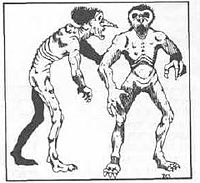 A last observation is the suggestion I found on Wikipedia that this novel influenced Gygax’s Dungeons & Dragons, most obviously by offering two quadrants for Gygax’s alignment system, but also by providing the regenerative abilities of the Troll from the Monster Manual. Alas that Dickson didn’t get the same treatment. The way Gygax apparently drew from everything else, why doesn’t Dickson’s sandmirk, from The Dragon and the George, ever make an appearance? Perhaps Gygax never read that novel? Or am I mistaken? Can anyone correct me?
A last observation is the suggestion I found on Wikipedia that this novel influenced Gygax’s Dungeons & Dragons, most obviously by offering two quadrants for Gygax’s alignment system, but also by providing the regenerative abilities of the Troll from the Monster Manual. Alas that Dickson didn’t get the same treatment. The way Gygax apparently drew from everything else, why doesn’t Dickson’s sandmirk, from The Dragon and the George, ever make an appearance? Perhaps Gygax never read that novel? Or am I mistaken? Can anyone correct me?
Finally, I want to express my thanks to Rich Horton for a late comment last entry that alerted me that Vault of the Ages was indeed a “boys’ novel” and that it had an interesting publication history with John C. Winston. I value everyone’s comments, but especially those that offer further education and scholarship like this one.
Trying to remember if I read this one or not. I did read Dragon & the George back in the day; if Goodreads is to be believed, D&G was published in 1976, which might be why it’s not referenced in D&D — it came out too late?
I know that Anderson’s conception of Law/Chaos predates Michael Moorcock’s, and Moorcock admits that he cribbed the notion from Anderson. But I bet that Moorcock’s more elaborate treatment of this concept was a much greater influence on Gygax than Anderson. Moorcock has a complex pantheon of both, as well as the Grey Lords (seemingly the neutral gods) that has a lot more direct influence upon the characters of his books.
I’ve read Three Hearts and Three Lions, but I don’t remember the Law/Chaos notion playing such a big part. I’ve often wondered if this distinction has any relation to the Eastern religious notion of yen and yang. As popularly described, they sound similar.
I can confirm that Gary had definitely read “Three Hearts and Three Lions,” and was influenced by it. I don’t know if he’d read “The Dragon and the George”–certainly Moldvay and I had, but we were late to the party.
Unfortunately, Gygax didn’t really think it through what he meant with alignment and just threw it into the game with barely a comment. Later writers tried to elaborate, but by that time the damage had already been done. 40 years later, people are still arguing “Your character wouldn’t do that!” ;/
[…] pattern reminds me of the triangle in Three Hearts and Three Lions, which consists of Holger Danske, the swan-may Alianora, and Morgan le Fey. At one point the latter […]
[…] readers can see the outlines of yet another Andersonian love triangle, one I first encountered in Three Hearts and Three Lions. But in this case the representation of the women is better. And this may be because of […]
[…] in The Golden Slave (and to lesser degrees in Three Hearts and Three Lions and in Virgin Planet) the major textures of Poul Anderson’s Rogue Sword sketch a love triangle. […]